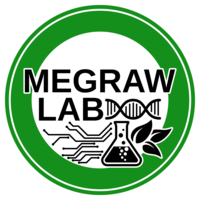Improved DNase-seq protocol facilitates high resolution mapping of DNase I hypersensitive sites in roots in Arabidopsis thaliana
Publication Online:
http://plantmethods.biomedcentral.com/articles/10.1186/s13007-015-0087-1
About this study:
Identifying cis-regulatory elements is critical in understanding the direct and indirect regulatory mechanisms of gene expression. Current approaches include DNase-seq, a technique that combines sensitivity to the nonspecific endonuclease DNase I with high throughput sequencing to identify regions of regulatory DNA on a genome-wide scale. While this method was originally developed for human cell lines, later adaptations made the processing of plant tissues possible. Challenges still remain in processing recalcitrant tissues that have low DNA content. By removing steps requiring the use of gel agarose plugs in DNase-seq, we were able to significantly reduce the time required to perform the protocol by at least 2 days, while also making possible the processing of difficult plant tissues. We refer to this simplified protocol as DNase I SIM (for simplified in-nucleus method). We were able to successfully create DNase-seq libraries for both leaf and root tissues in Arabidopsis using DNase I SIM. This protocol simplifies and facilitates generation of DNase-seq libraries from plant tissues for high resolution mapping of DNase I hypersensitive sites.
Protocol
Supplementary Materials
DNaseISIM_All_Supp_Mats_Bundle.zip
Supplementary Figures
- Additional_file_1.png: Distribution of DNase hypersensitive sites along Arabidopsis chromosomes. Previously published data was re-analyzed using replicates 1 and 2 from leaf tissue (Zhang et al., 2012). Approximate boundaries of Arabidopsis centromeres are shown in gray. Non-sequenced centromeric gaps are indicated by red circles. Positions of heterochromatic knobs are denoted by violet ellipses.
- Additional_file_2.png: Distribution of normalized DNase hypersensitive peaks along Arabidopsis chromosomes. Previously published data was re-analyzed using replicate 1 from leaf tissue (Zhang et al., 2012) and compared to our leaf data normalized to a similar read depth as replicate 1. Approximate boundaries of Arabidopsis centromeres are shown in gray. Non-sequenced centromeric gaps are indicated by red circles. Positions of heterochromatic knobs are denoted by violet ellipses.
- Additional_file_3.png: Distribution of DNase hypersensitive sites across genes. DHSs across our normalized leaf sample (left), and leaf replicate 1 using previously published data and re-analyzed (Zhang et al., 2012) (right). The x-axis represents the normalized gene length, with positions 1-500 indicating the first 500 bp upstream of the TSS, with the red line indicating the TSS. Positions 501-1500 indicate the gene body, with the green line indicating transcription termination. Positions 1501-2000 indicate the 500 bp downstream of the gene end.
- Additional_file_4.png: Distribution of overlapping and unique DNase hypersensitive sites in leaf data. Proportion of DNase hypersensitive sites identified as common to both our normalized leaf control and previously published leaf data (Zhang et al., 2012) that we re-analyzed, or that were uniquely identified in each data set.
- Additional_file_5.png: Examples of root- and leaf-specific genes associated with DNase hypersensitive sites. GBrowse screen shots show differential coverage by DNase-seq reads of root-specific (A) and leaf-specific (B) genes. For both panels (A) and (B), the top track 'Genes' identifies the genes that were annotated in a given region, the second track 'DNase I SIM Root' provides a histogram plot of the non-normalized read coverage found in our root data, the third track 'DNase I SIM Leaf' provides a histogram plot of the non-normalized read coverage found in our leaf data, and the fourth track 'DNase-seq Leaf (Zhang et al.)' provides a histogram plot of the read coverage from re-analyzed previously published leaf data (Zhang et al., 2012).
- Additional_file_7.png: Experimental flow chart of DNase I SIM protocol and preparation of DNase-seq libraries. Filling-in the DNA ends directly in nuclei (Steps 28-32) avoids embedding and manipulating nuclei in PFGE agarose plugs. This modification increases overall DNA yield and significantly shortens time required for DNA end repair by T4 polymerase as compared to agarose plugs (as described in the original DNase-seq protocol (Song and Crawford, 2010). Library construction steps (shaded box) are described in detail in (Song and Crawford, 2010), and step labeling is according to the original protocol provided in (Song and Crawford, 2010). Critical steps are marked by asterisks.
* If nuclei yield is lower than 106 nuclei per milliliter and/or nuclei are heavily contaminated with cell debris, do not proceed further.
** Termination of DNase I digestion with EDTA must be conducted rapidly at 4 degrees C and EDTA solution must be removed thoroughlly to avoid nuclei lysis and potential inhibition of T4 polymerase activity.
*** Concentration of DNA on membrane instead of ethanol precipitation is required to avoid solubility issues of high molecular weight DNA. If the mock sample is even slightly degraded, do not proceed further. Optimal digestion conditions can be assessed by using either 0.9 % SeaKem agarose gels or pulse field gel electrophoresis (PFGE) as described in (Song and Crawford, 2010). It is possible to optimize DNase I concentrations by first using PFGE, and later rapidly assess the digestion quality with pre-determined DNase I concentrations using SeaKem agarose gels.
**** Separation of amplified library from linker dimers (steps 39-43 described in (Song and Crawford, 2010)) is a critical procedure greatly affecting library quality. Separation of library from dimers in 4%-20% PAGE gel (steps 39-43, (Song and Crawford, 2010)) can be substituted by separation in 4.5% NuSieve TBE agarose gels (Lonza) followed by purification of the 86-bp band (containing linkers and insert) using PCR MinElute column (Qiagen).
Supplementary Tables
- Additional_file_8.xlsx: Detailed list of DNase I SIM changes. Side-by-side spreadsheet of differences at each step found between DNase I SIM and the DNase-seq protocols in (Song and Crawford, 2010) and (Zhang and Jiang, 2015).
Citation
If any of these materials are used for work which results in a publication, we would appreciate citation of the following article:
Cumbie JS, Filchkin SA, and Megraw M. (2015). Improved DNase-seq protocol facilitates high resolution mapping of DNase I hypersensitive sites in roots in Arabidopsis thaliana, Plant Methods, 11:42.

